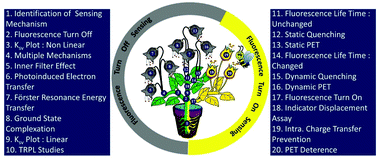Stepwise elucidation of fluorescence based sensing mechanisms considering picric acid as a model analyte
Abstract
In most of the sensing systems, specific detection mechanisms are involved during the detection process for a certain analyte irrespective of probes. However, unlike that of various sensing analytes, the detection of the highly toxic and explosive picric acid (PA) analyte was found to involve significant types of distinct sensing mechanisms depending on the nature of probes. Moreover, in the past five years, apart from the plethora of fluorescent probes designed, a number of unique organic small molecules and polymers have been strategically developed at our laboratory for the detection of PA, wherein the involvement of several diverse mechanisms along with a few new mechanisms depending on the electronic and photophysical properties of the probes has been unveiled. This involvement of several distinct mechanisms for the detection of PA motivated us to compile a step-by-step guide for the elucidation of the fluorescence sensing mechanism by taking PA as a model analyte. This “tutorial review” summarizes all the common sensing mechanisms involved for the detection of PA hitherto and provides a step-by-step guide to design experiments for the elucidation of sensing mechanisms for any newly designed sensing system. In addition to the appropriate classification of mechanisms involved for the fluorescence sensing of PA using various fluorescent systems developed at our laboratory, this tutorial review also includes most other possible mechanistic approaches studied previously. The present tutorial also provides a very unique method of a flow chart, which could help readers to elucidate the likely sensing mechanism via stepwise experimental and theoretical studies. Apart from the elucidation of the sensing mechanism for PA, this review presents an easy and distinct approach for the identification of all the involved mechanisms that would be of primary concern in the detection process of any analyte and could accurately help researchers in the easy and quick elucidation of sensing mechanisms in any kind of fluorophore-analyte system.



 Please wait while we load your content...
Please wait while we load your content...